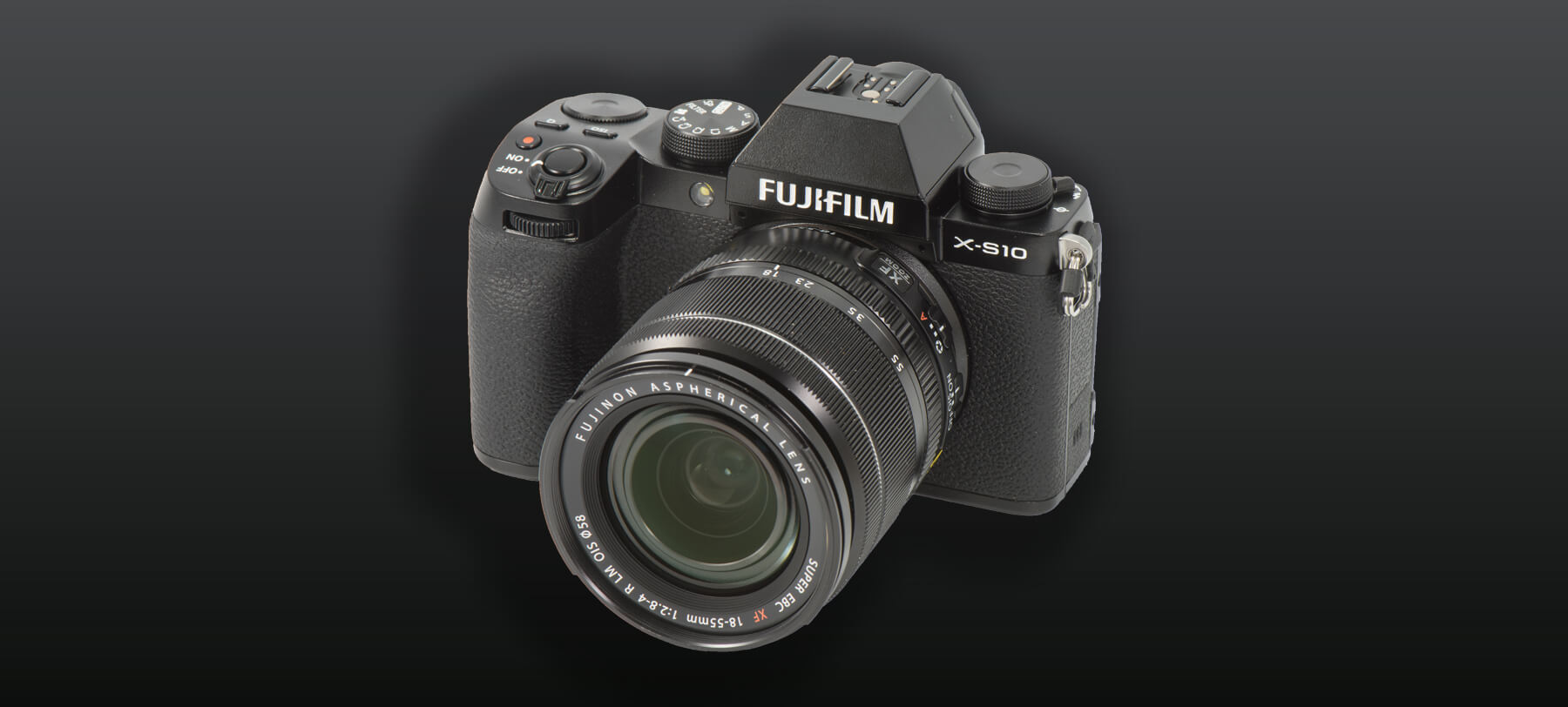
Fujifilm X-S10 test: huge potential
Posted on Jan 20, 2021
The Fujifilm X Series has many options for DSLR photographers looking to go mirrorless, with models such as the X-T30, X-T4 and X-Pro3 offering different body styles and control layouts at various price points. Those three cameras share the same 26.1-megapixel X-Trans CMOS 4 sensor, which has proved itself to be a top-drawer performer since it appeared in the X-T3, which came out in late 2018.
Fujifilm’s latest arrival is the X-S10, which is also centred on the same sensor and processing engine – the X-Processor 4 – but there has been innovation in its body shape and layout, so it’s a departure from some existing models. Its unmarked dials, pronounced pentaprism profile and sizable handgrip are all aspects designed to be more user-friendly and tempt current low- to mid-range DSLR users who are keen to go mirrorless and are looking for a more familiar-looking camera. That is backed up by a deep feature list for stills and movie shooting for a good price – the X-S10 with the XC15-45mm f/3.5-4.5 OIS PZ costs £999.
Click the images to see a larger view
We’ve already mentioned the sensor and processor, so let’s briefly run down a few other headline features. The X-S10 has a five-axis image stabiliser that is 30% smaller and lighter than that found in the X-T4. It has a benefit of 5-6EV, depending on the lens used. You can shoot at 30fps using the electronic shutter with a 1.25x crop or 20fps without a crop, and 8fps uncropped with the mechanical shutter, while autofocusing is handled by an intelligent on-sensor phase and contrast detect system that can work down to as low as -4EV. For movies, the X-S10 has options to shoot DCI and UHD 4K with ports for headphones (via an adapter) and a microphone. Power is provided by the NP-W126S battery – the same cell used on most Fujifilm X Series cameras – giving about 325 shots per charge, and there’s in-camera charging via the USB-C port. With a mains-connected adapter, full charge took less than two hours and charging with a power bank also worked fine.
The X-S10 is a very compact camera, smaller and lighter than most DSLRs and many mirrorless models, suiting photographers of all levels who are keen to downsize. I had the X-S10 sitting next to my X-T2 and it was clear that the new camera was shorter, thinner and not so wide. It was also obvious how much bigger the X-S10’s handgrip is, not just compared with the X-T2, but also in general terms. When I am out shooting, I like to carry the X-T2 in my right hand with the strap wrapped around my wrist for security. I’ve always been happy with this and found the grip comfortable. With the extra depth and girth of the X-S10’s grip, it felt so much more secure in my hand and the extra room for fingers meant my grip could actually be more relaxed and, consequently, less fatiguing. I’ve nothing but praise for the super-sized grip.
Performance: ISO
The X-S10’s native ISO range is 160 to 12,800, but it can expand to ISO 80, 25,600 and 51,200.
These pictures were shot with the X-S10 and 18-55mm f/2.8-4 lens. The camera’s long-exposure noise reduction was turned off and high ISO NR set to zero. No noise reduction was applied in processing, with the Raws going through Lightroom.
The X-S10 delivers a very good noise performance and you get very smooth, clean images, even at high ISOs. I am confident shooting at ISO 2500 or even ISO 3200 and know that I can get shots with blacks that are still solid and deep and, while grain is visible, its effect isn’t so strong as to impact on fine detail. With the help of some noise reduction during processing, I think Raws shot at this speed can give critically good large prints. Image quality gradually deteriorates from this point, but shots through to ISO 6400 are still good, and it’s only beyond this point that digital noise becomes more obvious.
Click the images to see a larger view
The camera’s build is reassuringly solid too, and it feels really robust, although it is worth noting that the body is not weatherproofed.
As part of Fujifilm’s plan to make this camera less intimidating to the uninitiated, there’s no dedicated ISO dial, but rather a button behind the shutter button. I’m someone who likes to tweak ISO as I shoot, so having a button here is ideal. Typical of Fujifilm, the ISO button is one of several controls that can be dedicated to adjusting ISO – of course, this applies to previous models, too. So if you prefer having the ISO button working as something else, there are 60 other options, and then you can dedicate the Fn or movie record button to adjust ISO – both have the same number of options. Or you can set it using the touchscreen – you can swipe up, down, left and right, and there are 55 options for each of those actions.
The thumb-operated rear command dial works with exposure compensation – a dial in the same spot carries out this function on other Fujifilm cameras. Though on the X-S10, it does have other roles. In manual exposure mode, it works as a shutter speed control, plus it lets you scroll through menus or AF zones in conjunction with the focus lever. On the downside you can’t look down at the dial and see at a glance what compensation value is set – you need to check the monitor or EVF.

While the compensation dial can’t be set to use other features, that’s not the case with the function dial on the far left of the body. This dial’s default role is to change Film Simulation mode, providing 12 main items, with filter options available in the Acros and black & white settings, taking the total to 18. There are 34 other options – including ISO – if you prefer to use this function dial in another way.
The shorter body is probably the reason why the Q button (which brings up the Quick menu) is sitting on the top-plate next to the ISO button. You can edit to suit what you like to use and have four, eight, 12 or 16 options on show in movie and still shooting.
On the back is a focus lever or joystick that, when pushed in and set to its default setting, zooms into the focus area in use and, when used as a joystick, lets you move the focus point or zone. The rear command dial also lets you adjust the working focus area. You can change this and have the focus lever off, move AF zone or pick out one face in a group, but I was happy with the default, especially the ‘zoom in at a press’ option, which was a fast way to check focus.
Of course, while the X-S10 is targeting potential DSLR switchers, it does not have an optical finder. Instead, there’s a very good electronic viewfinder that gives a lovely bright, detailed image, including when you’re using a magnified image to check focus. Its 2.36 million dot resolution is not the 3.69 million dots of the X-T4, but it is nevertheless great to use, with plenty of information on view. Dig into the menu and you can fine-tune what’s on show and even the size of key settings.
There’s the option of having no info except the actual image on show and that applies to the monitor, too.
The three-inch touch monitor has a 1.04 million dot resolution (the X-T4 has 1.62 million dots) and the screen itself swings out sideways. It can also be folded facing inwards if you prefer, or set to face forward for vlogging. A potential downside to a monitor that swings out to one side is that, if you’re a fan of using an L-grip, you may be limited to just having a standard mounting plate on the camera’s base.
Performance: Exposure latitude
This bracket was made using the X-S10’s autoexposure bracketing feature, with nine frames exposed at +/-1EV. The correctly exposed shot was made at 1/160sec at f/6.4 at ISO 160. Lightroom was used to make the exposure corrections, with exposure the only parameter adjusted.
The usual finding when we abuse Raws in this way is that overexposure is handled poorly compared with underexposure, and so it proved here. The +4EV shot was beyond recovery and the +3EV fared little better, with highlights suffering from a grey, veiled look. The +2EV improved to some extent, but even here recovery still resulted in a colour cast and stark highlights, so really only the +1EV shot could be fully recovered to a high standard.
Not unexpectedly, the underexposed Raws performed much better, with even the -4EV shot recovering very well – at least tonally. However, there was digital noise in the shadows and mid-tones. That noise decreased on the -3EV shot, and by the time we got to the -2EV shot, it looked identical to the correctly exposed shot. A good showing.
The moral of this tale is that if you are going to make a mess of the exposure, make sure the shot features underexposure.
I really enjoyed using the X-S10. Of course, I own Fujifilm X cameras already, so I’m familiar with the system and the menus. It still felt somewhat new, at least to start with, but I got used to the changes quickly and it was soon second nature.
In that respect, I think the X-S10’s design could attract those not invested in the Fujifilm system yet, which is the brand’s aim. On offer is a high-performing sensor, five-axis IBIS, swift AF, in-camera charging, and more.
With its feature set, it can surely appeal to current X Series owners, too. It’s a very portable camera – perfect for travel or as a backup – that delivers files as good as a ‘main’ camera. Of course, you could also say that of the X-T30, which is £200 cheaper.
There’s battery compatibility on the X-S10 too, (X-T4 owners excluded) since the X-S10 takes NP-W126S cells. However, its compact body does mean that there’s just one SD UHS-I card slot.
I had the camera long enough for a few shoots during the short and very cloudy days of late autumn, so let’s turn our attention to performance and the camera’s output.
Autofocusing was fast and mostly decisive, with hunting rare. When the light was really flat or the AF point aimed at a plain area, the AF system might track back and forth, but that’s not unusual. Generally, the system latched on speedily even in very low light. With the focus lever, I liked being able to nudge it to move the focus point about and immediately be able to change size using the rear command dial. With ‘all’ selected in the focus mode menu item, that gave the full range of focus areas immediately, but you can limit this – you can pick zone, for example.
Testing AF tracking and face/eye detect while shooting movies showed the system to be very capable. Eye detect worked with the 18-55mm at the wide end with a subject four metres away, so the target was pretty small, which was impressive.
The system also tracked well as the subject walked towards the camera and ducked in and out of view. The only thing I noticed was that it was a tad slow to pick up a subject entering the frame, but once the system acquired its target, it held on well – even when the face was partly turned away. I also had no issues with the X-S10’s autoexposure or white-balance systems and both performed very well and consistently. As such, there’s nothing to report in that area.
There’s nothing much to report on the five-axis sensor-shift IBIS system either, except that it worked very well for stills and movie shooting in equal measure. The maximum benefit is 6EV (depending on the lens) according to Fujifilm and using the supplied 18-55mm zoom, I carried out some tests at 55mm shooting down to 1sec. Assuming 1/125sec is the slowest handheld speed at that focal length, a 6EV benefit equates to shooting at 1/2sec. In my tests, that was achievable. I even managed to get a 100% success rate with the mechanical shutter at 1/15sec and 1/8sec. Granted, that dropped at 1/4sec and 1/2sec, but I was still getting a decent hit rate.

While the X-S10 is not touted as a speed monster, it still has a fast continuous shooting rate: it manages 8fps with the mechanical shutter. I achieved that speed in this test, acquiring 20 uncompressed Raws using a Lexar 64GB 2000X Professional SD card before buffering, which took about 10 seconds to clear. Shooting fine JPEGs, I got a run of 70 frames before buffering at 8fps, while with the electronic shutter, the shooting rate is supposed to leap up to 20fps uncropped – I got 18fps in my test.
The X-S10 is blessed with a good array of movie features, including DCI 4K, 4K UHD and Full HD, all with a 30-minute recording time. In Full HD, there is a 240fps mode that provides slow-motion effects. In this mode, there is a three-minute recording time limit. There’s a microphone port and headphones can be connected via the USB-C port using the supplied dongle. The USB-C port is also responsible for in-camera battery charging via the mains or a power bank.
To sum up, the X-S10 is a very accomplished camera with an impressive skill set that appeals to photographers of all levels and sells at a great price.
Verdict
The Fujifilm X-S10 is a terrific camera that is lovely to use and small enough to carry with you all the time – especially when partnered with a prime wide-angle, such as the XF23mm f/2. It’s very capable, too. I can see it appealing to DSLR owners considering going mirrorless, but also to current X Series owners who want a backup or to update their older model. The X-S10, which arrives with a body price of £949 (or £1299 with the XF18-55mm f/2.8-4 R LM OIS), is a genuine bargain.
Features: 23/25 The X-S10 is very well equipped for stills and movie capture, given its price
Handling: 24/25 Superb handgrip, huge customisation potential, swift autofocusing and in-camera battery charging
Performance: 24/25 The X-S10 delivers excellent Raws and out-of-camera JPEGs
Value for money: 24/25 Very competitive for the features on offer
Overall: 95/100 An impressive mirrorless camera with huge potential and great value, too
Pros Great sensor/processing engine, high ISO performance, compact, good handling, IBIS, excellent handgrip, function custom options, in-camera charging, focus lever functionality
Cons Battery life, one card slot might deter some
For more information, please visit the Fujifilm website.
There’s never been a better time to make good use
Where will your kit go next? Inspire others, make some extra cash and make a difference.
Sell your used kit and let someone else love it as much as you have. Make good use of your used gear. Sell yours today at MPB.


























